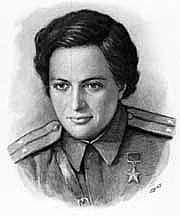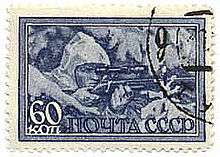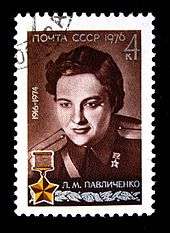Lyudmila Pavlichenko
| Lyudmila Mykhailivna Pavlichenko (Людмила Михайловна Павличенко) | |
|---|---|
 | |
| Nickname(s) | Lady Death[1] |
| Born |
July 12, 1916 Bila Tserkva, Russian Empire (now Bila Tserkva, Ukraine) |
| Died |
October 10, 1974 (aged 58) Moscow, Russian SFSR, Soviet Union (now Moscow, Russian Federation) |
| Allegiance |
|
| Service/branch |
|
| Years of service | 1941 – 1953 |
| Rank | Major |
| Unit | 25th Rifle Division |
| Battles/wars | |
| Awards |
Order of Lenin (twice) Hero of the Soviet Union Medal for Battle Merit Medal "For the Defence of Odessa" Medal "For the Defence of Sevastopol" Medal "For the Victory over Germany in the Great Patriotic War 1941–1945" |
| Other work | Soviet Committee of the Veterans of War |
Liudmyla Mykhailivna Pavlychenko (Ukrainian: Людмила Михайлівна Павличенко; Russian: Людмила Михайловна Павличенко, tr. Lyudmila Mikhailovna Pavlichenko; July 12, 1916 – October 10, 1974) was a Ukrainian Soviet sniper during World War II.[2] Credited with 309 kills, she is regarded as one of the top military snipers of all time[3] and the most successful female sniper in history.[4][5]
Early life and education
Born in Bila Tserkva on July 12, 1916, Pavlichenko (née Belova) moved to Kyiv with her family at the age of fourteen. There she joined a OSOAVIAKhIM shooting club and developed into an amateur sharpshooter, while working as a grinder at the Kyiv Arsenal factory.[6] In 1937, as a student of Kyiv University she completed a master's degree in history, focusing on the life of Bohdan Khmelnytsky.[7]
Career
World War II
In June 1941, 24-year-old Pavlichenko was in her fourth year of studying history at the Kyiv University when Germany began its invasion of the Soviet Union.[6] Pavlichenko was among the first round of volunteers at the recruiting office, where she requested to join the infantry and subsequently she was assigned to the Red Army's 25th Rifle Division;[6] Pavlichenko had the option of becoming a nurse but refused; "I joined the army when women were not yet accepted".[6] There she became one of 2,000 female snipers in the Red Army, of whom about 500 survived the war. She made her first two kills as a sniper near Belyayevka, using a Tokarev SVT-40 semi-automatic rifle with 3.5X telescopic sight.[6]


Private Pavlichenko fought for about two and a half months near Odessa where she recorded 187 kills.[7] When the Romanians gained control of Odessa her unit was sent to Sevastopol on the Crimean Peninsula,[7] where she fought for more than eight months.[6][8] In May 1942, Lieutenant Pavlichenko was cited by the Southern Army Council for killing 257 German soldiers. Her total of confirmed kills during World War II was 309,[5][6] including 36 enemy snipers.
In June 1942, Pavlichenko was wounded by mortar fire. Because of her growing status she was withdrawn from combat less than a month after recovering from her wound.
Visits to allied countries
Pavlichenko was sent to Canada and the United States for a publicity visit and became the first Soviet citizen to be received by a US President when Franklin Roosevelt welcomed her to the White House. Pavlichenko was later invited by Eleanor Roosevelt to tour America relating her experiences. While meeting with reporters in Washington, D.C. she was dumbfounded about the kind of questions put to her. "One reporter even criticized the length of the skirt of my uniform, saying that in America women wear shorter skirts and besides my uniform made me look fat".[4][9] Pavlichenko appeared before the International Student Assembly being held in Washington, D.C., and later attended CIO meetings and made appearances and speeches in New York City and Chicago. In Chicago, she stood before large crowds, chiding the men to support the second front. “Gentlemen,” she said, “I am 25 years old and I have killed 309 fascist invaders by now. Don’t you think, gentlemen, that you have been hiding behind my back for too long?” Her words settled on the crowd, then caused a surging roar of support.[10] The United States gave her a Colt semi-automatic pistol. In Canada she was presented with a sighted Winchester rifle now on display at the Central Armed Forces Museum in Moscow. While visiting in Canada along with Vladimir Pchelintsev (fellow sniper) and Nikolai Krasavchenko (Moscow fuel commissioner) they were greeted by thousands of people at Toronto's Union Station.
On Friday November 21, 1942, Lieutenant Pavlichenko visited Coventry, UK, and accepted donations of £4,516 from Coventry workers to pay for three X-ray units for the Red Army. She also visited Coventry Cathedral ruins, then the Alfred Herbert works and Standard Car Factory from where most funds had been raised. She had earlier in the day inspected a Birmingham factory.[11]
Having attained the rank of major, Pavlichenko never returned to combat but became an instructor and trained Soviet snipers until the war's end.[6] In 1943, she was awarded the Gold Star of the Hero of the Soviet Union,[12] and was commemorated on a Soviet postage stamp.
Later years and death
After the war, she finished her education at Kiev University and began a career as a historian. From 1945 to 1953, she was a research assistant of the Chief HQ of the Soviet Navy. She was later active in the Soviet Committee of the Veterans of War.[6] Pavlichenko died on October 10, 1974 at age 58, and was buried in the Novodevichye Cemetery in Moscow.[6][13]
A second Soviet commemorative stamp featuring Lyudmila Pavlichenko's portrait was issued in 1976.
Commemoration
Pavlichenko’s war record was recognized in the Soviet Union by two commemorative stamps with her portrait (see images above)[14] and in the United States, by a song ("Miss Pavlichenko") composed during World War II by folk singer Woody Guthrie, as a tribute to her war record and to memorialize her visits to the United States and Canada.[15] It was released as part of The Asch Recordings.[16][17]
Battle for Sevastopol (original Ukrainian title – "Незламна" ("Indestructible", "Unbreakable")), a biographical film about Lyudmila Pavlichenko, a joint Ukrainian-Russian production, was released in both countries on April 2, 2015. International premiere took place two weeks later at the Beijing International Film Festival.
See also
- Aleksandra Samusenko — World War II female Soviet Ukrainian tank commander
- Snipers of the Soviet Union
- Mosin–Nagant
- SVT-40
- List of female Heroes of the Soviet Union
References
- ↑ "Lady Death WWII sniper film aims for Russia and Ukraine release success - Daily Mail Online". Mail Online.
- ↑ Laws. "Secret Entertainment Today". secretentertainmenttoday.blogspot.de.
- ↑ The 10 deadliest snipers of all time, Business Insider (September 8, 2015)
- 1 2 Lady Sniper, TIME Magazine (Monday, September 28, 1942)
- 1 2 Pat Farey; Mark Spicer (5 May 2009). Sniping: An Illustrated History. MBI Publishing Company. p. 129. ISBN 978-0-7603-3717-2. Retrieved 18 March 2011.
- 1 2 3 4 5 6 7 8 9 10 Heroines of the Soviet Union 1941-45 by Henry Skaida, Osprey Publishing, 2003, ISBN 1841765988/ISBN 978-1841765983, page 31
- 1 2 3 Women and War: A Historical Encyclopedia from Antiquity to the Present originally from Ukraine by Arthur Bernard Cook, ABC-CLIO, 2006, ISBN 1851097708/ISBN 978-1851097708, page 457
- ↑ 1Павличенко Людмила Михайловна, Country's Heroes (warheroes.ru) (Russian)
- ↑ The World War Two Reader by Gordon Martel, Routledge, 2004, ISBN 0415224039/ISBN 978-0415224031, page 268
- ↑ Gilbert King. "Eleanor Roosevelt and the Soviet Sniper". Smithsonian.
- ↑ The Coventry Evening Telegraph, Saturday November 21st 1942
- ↑ Henry Sakaida; Christa Hook (2003), Heroines of the Soviet Union 1941-45, 90, Osprey Publishing, p. 21, ISBN 978-1-84176-598-3, retrieved 2011-12-03
- ↑ Maj Lyudmila Pavlichenko at Find a Grave
- ↑ Sakaida, Henry "Mankiller: Major Lyudmila Pavlichenko."http://www.soviet-awards.com/digest/pavlichenko/pavlichenko1.htm http://www.soviet-awards.com/digest/pavlichenko/pavlichenko2.htm
- ↑ "Miss Pavlichenko" dated to 1942 at http://www.woodyguthrie.de/pavil.html
- ↑ Hard Travelin': The Asch Recordings, Vol. 3,
- ↑ "Amazon.com: Miss Pavlichenko: Woody Guthrie: MP3 Downloads". amazon.com.
Further reading
- Valiant, Steve. Lady Death: The True Story of Russian Sniper Lyudmila Pavlichenko. 2015. ISBN 1518661203
External links
| Wikimedia Commons has media related to Lyudmila Pavlichenko. |